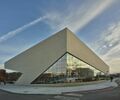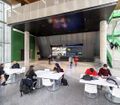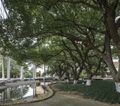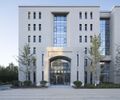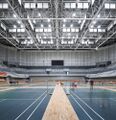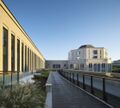Fortuna Institute: Difference between revisions
mNo edit summary Tag: 2017 source edit |
m (→Campus) |
||
| (18 intermediate revisions by 3 users not shown) | |||
| Line 1: | Line 1: | ||
{{Wip}} | |||
{{Infobox university | {{Infobox university | ||
| name = Fortuna Institute | | name = Fortuna Institute | ||
| Line 17: | Line 18: | ||
| religious_affiliation = | | religious_affiliation = | ||
| academic_affiliation = | | academic_affiliation = | ||
| endowment = $ | | endowment = $50.6 billion | ||
| chairman = Alexan Hovnatania | | chairman = Alexan Hovnatania | ||
| chancellor = Ludvík Sude | | chancellor = Ludvík Sude | ||
| Line 26: | Line 27: | ||
| postgrad = 44,589 | | postgrad = 44,589 | ||
| doctoral = 23,173 | | doctoral = 23,173 | ||
| city = | | city = Deonzanta | ||
| province = [[Isuriana]] | | province = [[Isuriana]] | ||
| country = Caphiria | | country = [[Caphiria]] | ||
| colors = Fortune Red, Fortune Gray | | colors = Fortune Red, Fortune Gray | ||
| athletics = ICAA D-1 | | athletics = ICAA D-1 | ||
| Line 40: | Line 41: | ||
| footnotes = | | footnotes = | ||
}} | }} | ||
'''Fortuna Institute''' is a private research university located in [[Isuriana]], [[Caphiria]]. Established in 1796, it has produced more politicians, business executives and world leaders than any other university in Caphiria and | '''Fortuna Institute''' is a [[Education in Caphiria#University|private research university]] located in [[Isuriana|Isuriana Province]], [[Caphiria]]. Established in 1796, it has produced more politicians, business executives, and world leaders than any other university in Caphiria and possibly the world. Ran by the Fortuna Corporation, Fortuna Institute has been one of the most elite places of higher learning due to its longstanding ties with nobility. The school was originally designed to be a place where the children of wealthy patrician families would go to become educated into proper politicians to ensure the preservation and growth of that family. Over time, due to political instability and economic windfalls, the school slowly eased its harsh restrictions and has become a liberal arts haven. | ||
The nominal cost of attendance is extremely high though due to its large endowment, it offers gracious financial aid packages for students who would otherwise never step foot on campus. It operates dozens of arts, cultural and scientific museums, as well as the free-to-the-public Fortuna Library located in the Liburnian District. With an endowment crossing $50 billion, Fortuna Institute has the largest of any educational institution in Caphiria by far. | |||
==Campus== | ==Campus== | ||
[[File:FortunaValley01.png|thumb|left|One of the "central hub" buildings of Fortuna Institute]] | [[File:FortunaValley01.png|thumb|left|One of the "central hub" buildings of Fortuna Institute]] | ||
Fortuna Institute is organized into eight primary campuses with additional faculties that cover the entire district of Inorni in the city [[Deonzanta]]. The entire Institute covers 37,065 acres, making it the largest school in the world. Each campus is unique in design and, over time, has developed its subculture. Across each campus are several "central hubs" which serve as universal meeting places for students. They are multi-purpose and are used for studying, events, parties, socializing, eating, and more. | |||
Fortuna Institute | The six campuses of Fortuna Institute are: | ||
* Fortuna Institute of Technology (FIT) | |||
* Fortuna Department of Research and Higher Education (DRHE) | |||
* Fortuna International Academy of Language and Culture (IALC) | |||
* Palaestrio Bellator Athletic Hall (''Fortuna Field'') | |||
* Montini School of Business (''The Chamber'') | |||
* Fortuna Law School (''Fortuna Hall'') | |||
Despite being three distinct campuses - the Fortuna Institute of Technology, the Department of Research and Higher Education, and the International Academy of Language and Culture are all physically located across a 209-acre area southwest of Deonzanta. This area is collectively called Fortuna Valley, or the Valley, and is known as the main campus of Fortuna Institute. | |||
Four miles east of Fortuna Valley lies the Palaestrio Bellator Athletic Hall, also known as Fortuna Field, where the athletic facilities and sports fields are. Fortuna Field covers 46,000 square miles between historical buildings such as Downes-Aldrich House and the Ciduon Va Railway Station and has dozens of facilities, including two 50,000-capacity modular stadiums and an 18.53-acre plaza. The complex includes multiple gymnasiums, training halls, and natatoriums and consists of a children's park, a supermarket, a fitness center, KTV, and a variety of catering spaces. Although Fortuna Field is designed mainly for sports activities, such as basketball, volleyball, tennis, ice hockey, boxing, etc., it can harbor such cultural activities as concerts and congresses. | |||
North of Fortuna Field is the Montini School of Business, commonly known as "The Chamber" for its iconic main building. The Chamber consists of three building plazas situated on 25 acres. | |||
West of the Chamber and nestled right on the Marcatarolo Canal is Fortuna Law School, known as Fortuna Hall. | |||
===Fortune Valley=== | |||
. . . | |||
=== | ==== Fortuna Institute of Technology ==== | ||
==== Department of Research and Higher Education ==== | |||
==== International Academy of Language and Culture ==== | |||
===Fortuna | ===Fortuna Field=== | ||
[[File:Fortuna Sports05.jpg|thumb|One of the modular stadiums and facilities of Fortuna Field |alt=|left]] | |||
. . . | |||
===The Chamber=== | |||
[[File:Fortuna Chamber 01.jpg|thumb|The main building of The Chamber|alt=|left]] | |||
. . . | |||
===Fortuna Hall=== | |||
[[File:Fortuna Law 01.jpg|thumb|One of the buildings in Fortuna Hall|alt=|left]] | |||
. . . | |||
==Organization and administration== | ==Organization and administration== | ||
The Fortuna Institute, as well as virtually all of Caphiria's prestigious higher and lower education schools, is governed by the Fortuna Corporation. The Fortuna Corporation hires staff and faculty, maintains facilities, and handles higher administrative duties. Fortuna Institute employs over 12,000 staff and faculty who instruct | The Fortuna Institute, as well as virtually all of Caphiria's prestigious higher and lower education schools, is governed by the Fortuna Corporation. The Fortuna Corporation hires staff and faculty, maintains facilities, and handles higher administrative duties. Fortuna Institute employs over 12,000 staff and faculty who instruct about 100,000 students across many schools. | ||
The school colors are Fortune Red and Fortune Gray, which can be traced back to before the formation of the school and has deep symbolic meaning. | The school colors are Fortune Red and Fortune Gray, which can be traced back to before the formation of the school and has deep symbolic meaning. | ||
Fortuna Institute has the largest university endowment in the world | Fortuna Institute has the largest university endowment in the world by far. As of 2020, Fortuna Institute had a total financial aid reserve of $400 million for students. | ||
==Academics== | ==Academics== | ||
===Admission=== | ===Admission=== | ||
Undergraduate admission to Fortuna is characterized as "more selective, lower transfer-in" | Undergraduate admission to Fortuna is characterized as "more selective, lower transfer-in." Fortuna accepted 3.3% of applicants for the class of 2030, a record low and the second-lowest acceptance rate among all national universities. Fortuna Institute ended its early admissions program in 2027 as it was believed to disadvantage low-income and underrepresented minority applicants applying to selective universities. Yet, for the class of 2030, an Early Action program was reintroduced. | ||
===Teaching and learning=== | ===Teaching and learning=== | ||
Fortuna is a large, highly residential research university. The university has been accredited by the Caphirian Association of Schools and Colleges since 1929. The university offers 46 undergraduate concentrations (majors), 134 graduate degrees, and 40 professional degrees. For the 2029–2030 academic year, Fortuna granted 1,664 baccalaureate degrees, 800 master's degrees, 5120 doctoral degrees, and 4,460 professional degrees. | Fortuna is a large, highly residential research university. The university has been accredited by the Caphirian Association of Schools and Colleges since 1929. The university offers 46 undergraduate concentrations (majors), 134 graduate degrees, and 40 professional degrees. For the 2029–2030 academic year, Fortuna granted 1,664 baccalaureate degrees, 800 master's degrees, 5120 doctoral degrees, and 4,460 professional degrees. | ||
The four-year, full-time undergraduate program comprises a minority of enrollments at the university and emphasizes instruction with an "arts and sciences focus" | The four-year, full-time undergraduate program comprises a minority of enrollments at the university and emphasizes instruction with an "arts and sciences focus." Between 1978 and 2008, entering students were required to complete a core curriculum of seven classes outside of their concentration. Since 2008, undergraduate students have been required to complete courses in eight General Education categories: Aesthetic and Interpretive Understanding, Culture and Belief, Empirical and Mathematical Reasoning, Ethical Reasoning, Science of Living Systems, Science of the Physical Universe, Societies of the World, and Caphiria in the World. Fortuna offers a comprehensive doctoral graduate program, and there is a high level of coexistence between graduate and undergraduate degrees. | ||
Fortuna's academic programs operate on a semester calendar beginning in early September and ending in mid-May. Undergraduates typically take four half-courses per term and must maintain a four-course rate average to be considered full-time. In many concentrations, students can elect to pursue a basic program or an honors-eligible program requiring a senior thesis and/or advanced | Fortuna's academic programs operate on a semester calendar beginning in early September and ending in mid-May. Undergraduates typically take four half-courses per term and must maintain a four-course rate average to be considered full-time. In many concentrations, students can elect to pursue a basic program or an honors-eligible program requiring a senior thesis and/or advanced coursework. Students graduating in the top 4–5% of the class are awarded degrees ''summa cum laude'', students in the next 15% of the course are awarded magna cum laude, and the next 30% of the class are awarded cum laude. Fortuna has chapters of academic honor societies, and various committees and departments also award several hundred named prizes annually. Fortuna, along with other universities, has been accused of grade inflation, although there is evidence that the quality of the student body and its motivation have also increased. Fortuna Institute reduced the number of students who received Latin honors from 90% in 2004 to 60% in 2005. Moreover, the honors of "Pat Nysdrine Scholar" and "Fortuna College Scholar" will now be given only to the top 5 percent and the next 5 percent of each class. | ||
University policy is to expel students engaging in academic dishonesty to discourage a "culture of cheating." In 2024, dozens of students were expelled for cheating after an investigation of more than 120 students.In 2025, | University policy is to expel students engaging in academic dishonesty to discourage a "culture of cheating." In 2024, dozens of students were expelled for cheating after an investigation of more than 120 students. In 2025, it was reported that as many as 42% of incoming freshmen had cheated on homework before entering the university. These incidents have prompted the university to consider adopting an honor code. | ||
For 2025-26, the school year's annual tuition was $63,000, with a total cost of attendance of $88,000. Beginning in 2030, families with incomes below $60,000 pay nothing for their children to attend, including room and board. Families with incomes between $60,000 to $80,000 pay only a few thousand dollars a year, and families earning between $120,000 and $180,000 pay no more than 10% of their annual incomes. In 2009, Fortuna offered grants totaling $414 million across all eleven divisions; $340 million came from institutional funds, $35 million from federal support, and $39 million from other outside help. Grants total 88% of Fortuna's aid for undergraduate students, with aid also provided by loans (8%) and work-study (4%). | |||
===Research=== | ===Research=== | ||
Fortuna is a founding member of the Association of Sarpedonic Universities and remains a research university with "very high" research activity and a "comprehensive" doctoral program across the arts, sciences, engineering, and medicine. Research and development expenditures in 2014 totaled $69.7 billion. | Fortuna is a founding member of the Association of Sarpedonic Universities and remains a research university with "very high" research activity and a "comprehensive" doctoral program across the arts, sciences, engineering, and medicine. Research and development expenditures in 2014 totaled $69.7 billion. | ||
===Libraries and museums=== | |||
The Fortuna Institute Library System is centered in ''Forte Bilbiotheca'' in Fortuna Hall and comprises nearly 80 individual libraries holding over 18 million volumes. There are rare books, manuscripts, and other special collections throughout Fortuna's libraries; Apex Library, Labyrinth Bilbiotheca, and Paragon Library, and the Fortuna University Archives consist principally of rare and unique materials. | |||
Fortuna operates several arts, cultural, and scientific museums. The Fortuna Art Museums comprises three museums. The Aeos Museum includes collections of ancient Caphirian, Latin, and later Vannoisian art, the Revelation Museum, formerly the Oracle Museum, covers central and northern Sarpedonic art, and the Tempest Museum of Art covers [[Occidental world|Western]] art from the Middle Ages to the present emphasizing Latin early Renaissance, Vannosian pre-imperial, and 19th-century Ghantish art. The Fortuna Museum of Natural History includes the Fortuna Mineralogical Museum, Fortuna University Herbaria featuring the Milanepi Glass Flowers exhibit, and the Museum of Comparative Zoology. Other museums include the Forte Center for the Visual Art, housing the film archive, and the Cimonte Museum of Archaeology and Ethnology, specializing in cultural history and civilizations. | |||
The Fortuna | == Campus life == | ||
Fortuna is known for its vibrant campus life, with over 350 student organizations on campus. The university also has a number of a cappella groups, including the Fortuna Din & Tone Deafs, the Fortuna Glee Club, and the Fortuna Harmonizers. The Fortuna Institute Band, known as the "Marching Band," is a student-run organization that performs at home football games and other events. | |||
Fortuna has a number of athletic facilities, including the Palaestrio Bellator Athletic Hall, which houses multiple gymnasiums, training halls, and natatoriums. The university also has multiple sports fields and facilities, including two 50,000-capacity modular stadiums and an 18.53-acre plaza. Fortuna fields 41 varsity sports teams, known as the Fortuna Parliament, which compete in the [[Sarpedon Athletic Association]] (SAA). The university has won a total of 36 SAA championships in various sports. | |||
Fortuna | Fortuna also has a number of social and cultural events, including the annual Fortuna Film Festival, the Spring Fling, and the Fortuna Arts Festival. The university also has a number of student publications, including The Fortuna Tribune, a student-run newspaper, and The Fortuna Record, a student-run podcast. | ||
==Gallery== | ==Gallery== | ||
<gallery> | |||
File:Fortuna CentralHub 02.jpg|A "central hub" of Fortuna Institute | |||
File:Fortuna Chamber 01.jpg|Exterior of the main Fortuna Chamber building | |||
File:Fortuna Field 01.jpg|Fortuna Field training facility | |||
File:Fortuna CentralHub 03.jpg|Inside a central hub | |||
File:Fortuna Valley 02.jpg|Inside a Fortuna Valley building | |||
File:Fortuna Sports05.jpg|Modular Fortuna Field stadium and facilities | |||
File:Fortuna Chamber 04.jpg|Inside the main Fortuna Chamber building | |||
File:Fortuna Law 02.jpg|Part of the Fortuna Hall campus | |||
File:Fortuna Valley 05.jpg|Hallway and social space at Fortuna Valley | |||
File:Fortuna Law 04.jpg|Gardens at Fortuna Hall | |||
File:Fortuna Chamber 03.jpg|Entrance to the main Fortuna Chamber building | |||
File:Fortuna Field 02.jpg|Inside a Fortuna Field training facility | |||
File:Fortuna Chamber 05.jpg|Exterior of a Fortuna Chamber building | |||
File:Fortuna Chamber 02.jpg|Inside the main Fortuna Chamber building | |||
File:Fortuna Law 03.jpg|Part of the Fortuna Hall campus | |||
File:Fortuna Valley 03.jpg|Inside a classroom at Fortuna Valley | |||
File:Fortuna Sports04.jpg|Tennis court at a Fortuna Field facility | |||
File:Fortuna Chamber 07.jpg|Outside of a Fortuna Chamber building | |||
File:Fortuna Valley 01.jpg|Fortuna Valley campus | |||
File:Fortuna Sports08.jpg|Inside a Fortuna Field facility | |||
File:Fortuna Chamber 06.jpg|Outside of a Fortuna Chamber building | |||
File:Fortuna Sports0.jpg|Inside a modular Fortuna Field facility | |||
File:Fortuna Chamber 09.jpg|Outside of a Fortuna Chamber building, showing walkways | |||
File:Fortuna Field 04.jpg|Basketball training facility at Fortuna Field | |||
File:Fortuna Chamber 08.jpg|Outside of a Fortuna Chamber building, showing walkways | |||
File:Fortuna Sports02.jpg|Modular Fortuna Field stadium and facilities | |||
File:Fortuna Field 03.jpg|Outside a Fortuna Field facility | |||
File:Fortuna Valley 04.jpg|Atrium at Fortuna Valley | |||
</gallery> | |||
==See also== | |||
[[Category:Education]] | [[Category:Education]] | ||
[[Category:Colleges]] | [[Category:Colleges]] | ||
[[Category:Caphiria]] | [[Category:Caphiria]] | ||
[[Category:Education in Caphiria]] | [[Category:Education in Caphiria]] | ||
[[Category:IXWB]] | |||
Latest revision as of 15:21, 4 January 2023
This article is a work-in-progress because it is incomplete and pending further input from an author. Note: The contents of this article are not considered canonical and may be inaccurate. Please comment on this article's talk page to share your input, comments and questions. |
 | |
| Latin: Universitatis Fortuna | |
| Motto | Scientia, Aqua Et Rex |
|---|---|
Motto in English | Knowledge, Water And King |
| Type | Private - Research |
| Established | 14 Aug 1796 |
Parent institution | The Fortuna Corporation |
| Endowment | $50.6 billion |
| Chairman | Alexan Hovnatania |
| Chancellor | Ludvík Sude |
| Dean | Lucia Burcanius |
Academic staff | 12,150 |
| Students | 100,000 |
| Undergraduates | 32,238 |
| Postgraduates | 44,589 |
| 23,173 | |
| Location | Deonzanta , , |
| Colors | Fortune Red, Fortune Gray |
| Athletics | ICAA D-1 |
| Sports | 33 varsity teams |
| Mascot | Kerry the Kebab Killer |
Fortuna Institute is a private research university located in Isuriana Province, Caphiria. Established in 1796, it has produced more politicians, business executives, and world leaders than any other university in Caphiria and possibly the world. Ran by the Fortuna Corporation, Fortuna Institute has been one of the most elite places of higher learning due to its longstanding ties with nobility. The school was originally designed to be a place where the children of wealthy patrician families would go to become educated into proper politicians to ensure the preservation and growth of that family. Over time, due to political instability and economic windfalls, the school slowly eased its harsh restrictions and has become a liberal arts haven.
The nominal cost of attendance is extremely high though due to its large endowment, it offers gracious financial aid packages for students who would otherwise never step foot on campus. It operates dozens of arts, cultural and scientific museums, as well as the free-to-the-public Fortuna Library located in the Liburnian District. With an endowment crossing $50 billion, Fortuna Institute has the largest of any educational institution in Caphiria by far.
Campus
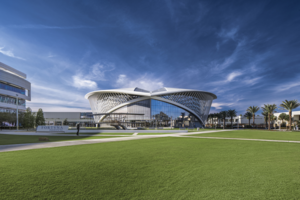
Fortuna Institute is organized into eight primary campuses with additional faculties that cover the entire district of Inorni in the city Deonzanta. The entire Institute covers 37,065 acres, making it the largest school in the world. Each campus is unique in design and, over time, has developed its subculture. Across each campus are several "central hubs" which serve as universal meeting places for students. They are multi-purpose and are used for studying, events, parties, socializing, eating, and more.
The six campuses of Fortuna Institute are:
- Fortuna Institute of Technology (FIT)
- Fortuna Department of Research and Higher Education (DRHE)
- Fortuna International Academy of Language and Culture (IALC)
- Palaestrio Bellator Athletic Hall (Fortuna Field)
- Montini School of Business (The Chamber)
- Fortuna Law School (Fortuna Hall)
Despite being three distinct campuses - the Fortuna Institute of Technology, the Department of Research and Higher Education, and the International Academy of Language and Culture are all physically located across a 209-acre area southwest of Deonzanta. This area is collectively called Fortuna Valley, or the Valley, and is known as the main campus of Fortuna Institute.
Four miles east of Fortuna Valley lies the Palaestrio Bellator Athletic Hall, also known as Fortuna Field, where the athletic facilities and sports fields are. Fortuna Field covers 46,000 square miles between historical buildings such as Downes-Aldrich House and the Ciduon Va Railway Station and has dozens of facilities, including two 50,000-capacity modular stadiums and an 18.53-acre plaza. The complex includes multiple gymnasiums, training halls, and natatoriums and consists of a children's park, a supermarket, a fitness center, KTV, and a variety of catering spaces. Although Fortuna Field is designed mainly for sports activities, such as basketball, volleyball, tennis, ice hockey, boxing, etc., it can harbor such cultural activities as concerts and congresses.
North of Fortuna Field is the Montini School of Business, commonly known as "The Chamber" for its iconic main building. The Chamber consists of three building plazas situated on 25 acres.
West of the Chamber and nestled right on the Marcatarolo Canal is Fortuna Law School, known as Fortuna Hall.
Fortune Valley
. . .
Fortuna Institute of Technology
Department of Research and Higher Education
International Academy of Language and Culture
Fortuna Field
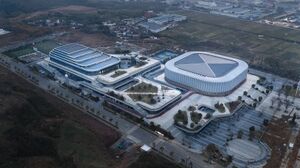
. . .
The Chamber
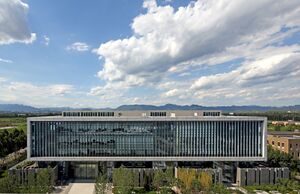
. . .
Fortuna Hall
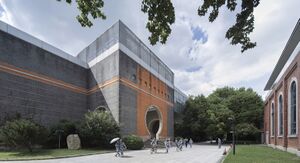
. . .
Organization and administration
The Fortuna Institute, as well as virtually all of Caphiria's prestigious higher and lower education schools, is governed by the Fortuna Corporation. The Fortuna Corporation hires staff and faculty, maintains facilities, and handles higher administrative duties. Fortuna Institute employs over 12,000 staff and faculty who instruct about 100,000 students across many schools.
The school colors are Fortune Red and Fortune Gray, which can be traced back to before the formation of the school and has deep symbolic meaning.
Fortuna Institute has the largest university endowment in the world by far. As of 2020, Fortuna Institute had a total financial aid reserve of $400 million for students.
Academics
Admission
Undergraduate admission to Fortuna is characterized as "more selective, lower transfer-in." Fortuna accepted 3.3% of applicants for the class of 2030, a record low and the second-lowest acceptance rate among all national universities. Fortuna Institute ended its early admissions program in 2027 as it was believed to disadvantage low-income and underrepresented minority applicants applying to selective universities. Yet, for the class of 2030, an Early Action program was reintroduced.
Teaching and learning
Fortuna is a large, highly residential research university. The university has been accredited by the Caphirian Association of Schools and Colleges since 1929. The university offers 46 undergraduate concentrations (majors), 134 graduate degrees, and 40 professional degrees. For the 2029–2030 academic year, Fortuna granted 1,664 baccalaureate degrees, 800 master's degrees, 5120 doctoral degrees, and 4,460 professional degrees.
The four-year, full-time undergraduate program comprises a minority of enrollments at the university and emphasizes instruction with an "arts and sciences focus." Between 1978 and 2008, entering students were required to complete a core curriculum of seven classes outside of their concentration. Since 2008, undergraduate students have been required to complete courses in eight General Education categories: Aesthetic and Interpretive Understanding, Culture and Belief, Empirical and Mathematical Reasoning, Ethical Reasoning, Science of Living Systems, Science of the Physical Universe, Societies of the World, and Caphiria in the World. Fortuna offers a comprehensive doctoral graduate program, and there is a high level of coexistence between graduate and undergraduate degrees.
Fortuna's academic programs operate on a semester calendar beginning in early September and ending in mid-May. Undergraduates typically take four half-courses per term and must maintain a four-course rate average to be considered full-time. In many concentrations, students can elect to pursue a basic program or an honors-eligible program requiring a senior thesis and/or advanced coursework. Students graduating in the top 4–5% of the class are awarded degrees summa cum laude, students in the next 15% of the course are awarded magna cum laude, and the next 30% of the class are awarded cum laude. Fortuna has chapters of academic honor societies, and various committees and departments also award several hundred named prizes annually. Fortuna, along with other universities, has been accused of grade inflation, although there is evidence that the quality of the student body and its motivation have also increased. Fortuna Institute reduced the number of students who received Latin honors from 90% in 2004 to 60% in 2005. Moreover, the honors of "Pat Nysdrine Scholar" and "Fortuna College Scholar" will now be given only to the top 5 percent and the next 5 percent of each class.
University policy is to expel students engaging in academic dishonesty to discourage a "culture of cheating." In 2024, dozens of students were expelled for cheating after an investigation of more than 120 students. In 2025, it was reported that as many as 42% of incoming freshmen had cheated on homework before entering the university. These incidents have prompted the university to consider adopting an honor code.
For 2025-26, the school year's annual tuition was $63,000, with a total cost of attendance of $88,000. Beginning in 2030, families with incomes below $60,000 pay nothing for their children to attend, including room and board. Families with incomes between $60,000 to $80,000 pay only a few thousand dollars a year, and families earning between $120,000 and $180,000 pay no more than 10% of their annual incomes. In 2009, Fortuna offered grants totaling $414 million across all eleven divisions; $340 million came from institutional funds, $35 million from federal support, and $39 million from other outside help. Grants total 88% of Fortuna's aid for undergraduate students, with aid also provided by loans (8%) and work-study (4%).
Research
Fortuna is a founding member of the Association of Sarpedonic Universities and remains a research university with "very high" research activity and a "comprehensive" doctoral program across the arts, sciences, engineering, and medicine. Research and development expenditures in 2014 totaled $69.7 billion.
Libraries and museums
The Fortuna Institute Library System is centered in Forte Bilbiotheca in Fortuna Hall and comprises nearly 80 individual libraries holding over 18 million volumes. There are rare books, manuscripts, and other special collections throughout Fortuna's libraries; Apex Library, Labyrinth Bilbiotheca, and Paragon Library, and the Fortuna University Archives consist principally of rare and unique materials.
Fortuna operates several arts, cultural, and scientific museums. The Fortuna Art Museums comprises three museums. The Aeos Museum includes collections of ancient Caphirian, Latin, and later Vannoisian art, the Revelation Museum, formerly the Oracle Museum, covers central and northern Sarpedonic art, and the Tempest Museum of Art covers Western art from the Middle Ages to the present emphasizing Latin early Renaissance, Vannosian pre-imperial, and 19th-century Ghantish art. The Fortuna Museum of Natural History includes the Fortuna Mineralogical Museum, Fortuna University Herbaria featuring the Milanepi Glass Flowers exhibit, and the Museum of Comparative Zoology. Other museums include the Forte Center for the Visual Art, housing the film archive, and the Cimonte Museum of Archaeology and Ethnology, specializing in cultural history and civilizations.
Campus life
Fortuna is known for its vibrant campus life, with over 350 student organizations on campus. The university also has a number of a cappella groups, including the Fortuna Din & Tone Deafs, the Fortuna Glee Club, and the Fortuna Harmonizers. The Fortuna Institute Band, known as the "Marching Band," is a student-run organization that performs at home football games and other events.
Fortuna has a number of athletic facilities, including the Palaestrio Bellator Athletic Hall, which houses multiple gymnasiums, training halls, and natatoriums. The university also has multiple sports fields and facilities, including two 50,000-capacity modular stadiums and an 18.53-acre plaza. Fortuna fields 41 varsity sports teams, known as the Fortuna Parliament, which compete in the Sarpedon Athletic Association (SAA). The university has won a total of 36 SAA championships in various sports.
Fortuna also has a number of social and cultural events, including the annual Fortuna Film Festival, the Spring Fling, and the Fortuna Arts Festival. The university also has a number of student publications, including The Fortuna Tribune, a student-run newspaper, and The Fortuna Record, a student-run podcast.
Gallery
-
A "central hub" of Fortuna Institute
-
Exterior of the main Fortuna Chamber building
-
Fortuna Field training facility
-
Inside a central hub
-
Inside a Fortuna Valley building
-
Modular Fortuna Field stadium and facilities
-
Inside the main Fortuna Chamber building
-
Part of the Fortuna Hall campus
-
Hallway and social space at Fortuna Valley
-
Gardens at Fortuna Hall
-
Entrance to the main Fortuna Chamber building
-
Inside a Fortuna Field training facility
-
Exterior of a Fortuna Chamber building
-
Inside the main Fortuna Chamber building
-
Part of the Fortuna Hall campus
-
Inside a classroom at Fortuna Valley
-
Tennis court at a Fortuna Field facility
-
Outside of a Fortuna Chamber building
-
Fortuna Valley campus
-
Inside a Fortuna Field facility
-
Outside of a Fortuna Chamber building
-
Inside a modular Fortuna Field facility
-
Outside of a Fortuna Chamber building, showing walkways
-
Basketball training facility at Fortuna Field
-
Outside of a Fortuna Chamber building, showing walkways
-
Modular Fortuna Field stadium and facilities
-
Outside a Fortuna Field facility
-
Atrium at Fortuna Valley


